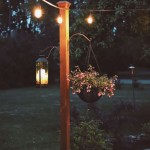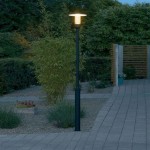Outdoor Sensor Lights for House: Enhancing Security and Convenience
Outdoor sensor lights are becoming increasingly popular for residential properties, offering a blend of security enhancement, convenience, and energy efficiency. These lights, triggered by motion or changes in ambient light, provide illumination exactly when and where it is needed, contributing to a safer and more welcoming home environment. Understanding the types, benefits, and installation considerations of outdoor sensor lights is crucial for homeowners seeking to improve their property.
The core function of an outdoor sensor light lies in its ability to detect movement or changes in light levels. When a sensor detects activity within its designated range, the light activates, illuminating the area. This immediate illumination can deter potential intruders, alert homeowners to approaching visitors, and provide visibility in areas that are otherwise dark and potentially hazardous.
There are two primary types of sensors used in outdoor lighting: motion sensors and light sensors (also known as photocells). Motion sensors detect movement using various technologies, while light sensors detect changes in the overall brightness of the environment.
Understanding Different Types of Outdoor Sensor Lights
The market offers a wide variety of outdoor sensor lights, each with its own set of features and applications. Understanding these differences is key to selecting the right lights for specific needs.
Motion Sensor Lights: These lights use motion sensors to detect movement within a specified area. Common motion sensor technologies include Passive Infrared (PIR), Microwave, and Dual Technology.
- Passive Infrared (PIR) Sensors: PIR sensors detect changes in infrared radiation emitted by warm objects, such as people, animals, and vehicles. They are widely used due to their affordability and relatively low power consumption. However, PIR sensors can be susceptible to false triggers from heat sources like sunlight or car engines.
- Microwave Sensors: Microwave sensors emit microwave radiation and detect changes in the reflected waves caused by moving objects. They offer a wider detection range and are less prone to false triggers from heat compared to PIR sensors. However, they can be more expensive and may be susceptible to interference from other microwave devices.
- Dual Technology Sensors: These sensors combine PIR and microwave technology. Both sensors must be triggered simultaneously to activate the light, significantly reducing the likelihood of false alarms.
Photocell Lights: Also known as dusk-to-dawn lights, these lights use photocells to detect the level of ambient light. They automatically turn on when it gets dark and turn off when it gets light. Photocell lights are ideal for providing continuous illumination throughout the night, such as lighting up walkways or entryways.
LED Sensor Lights: LED technology has revolutionized outdoor lighting, offering significant advantages over traditional incandescent or halogen bulbs. LED sensor lights are energy-efficient, long-lasting, and provide instant-on illumination. They are available in a variety of brightness levels and color temperatures to suit different applications.
Solar Powered Sensor Lights: Solar-powered sensor lights utilize solar panels to collect energy from the sun during the day and store it in rechargeable batteries. These lights are environmentally friendly and require no wiring, making them easy to install in remote locations. However, their performance can be affected by weather conditions and the amount of sunlight available.
Benefits of Using Outdoor Sensor Lights
The adoption of outdoor sensor lights for residential properties comes with a multitude of benefits. These advantages not only improve the security and functionality of a home but also contribute to energy savings and overall convenience.
Enhanced Security: One of the primary benefits of outdoor sensor lights is their ability to deter crime. The sudden illumination triggered by motion can startle potential intruders and discourage them from approaching the property. Strategically placed sensor lights can illuminate dark corners, walkways, and entrances, making it more difficult for intruders to hide.
Increased Safety: Outdoor sensor lights can improve safety by providing visibility in areas that are otherwise dark and potentially hazardous. This is particularly important for pathways, steps, and driveways. The illumination helps prevent trips, falls, and other accidents, especially during nighttime hours.
Energy Efficiency: Sensor lights only activate when needed, reducing energy consumption compared to lights that are left on continuously. This is especially true for LED sensor lights, which are highly energy-efficient. By using motion or light sensors, homeowners can significantly lower their energy bills and reduce their carbon footprint.
Convenience: Sensor lights offer convenience by automatically providing illumination when needed. Homeowners do not have to manually turn lights on and off, which is particularly useful when arriving home late at night or carrying heavy packages. Dusk-to-dawn lights also provide continuous illumination without requiring any user intervention.
Property Value: Installing outdoor sensor lights can increase the value of a home. These lights enhance the curb appeal of the property and provide peace of mind to potential buyers, knowing that the home is well-protected and energy-efficient.
Customization: Many outdoor sensor lights offer customizable settings, such as sensitivity adjustments, timer settings (duration of illumination), and detection range. This allows homeowners to tailor the lights to their specific needs and preferences. For example, the sensitivity can be adjusted to avoid triggering the light by small animals, and the timer can be adjusted to turn off the light after a specific period of inactivity.
Installation and Maintenance Considerations
Proper installation and regular maintenance are crucial for ensuring the optimal performance and longevity of outdoor sensor lights.
Installation: The installation process will vary depending on the type of light and the existing electrical infrastructure.
- Wired Lights: Wired sensor lights require connection to the home's electrical system. It is recommended to hire a qualified electrician to ensure safe and proper installation. The electrician can determine the appropriate wiring, mounting location, and circuit protection.
- Wireless Lights: Wireless sensor lights, such as solar-powered lights, are easier to install as they do not require any wiring. Simply mount the light in a suitable location, ensuring that it is exposed to sufficient sunlight for charging.
Placement: The placement of outdoor sensor lights is critical for their effectiveness. Consider the following factors when choosing a location:
- Detection Range: Ensure that the sensor's detection range covers the desired area. This may involve testing the range and adjusting the sensor accordingly.
- Obstructions: Avoid placing the light behind obstructions that could block the sensor's view. Trees, shrubs, and fences can interfere with the detection of movement or light.
- False Triggers: Consider potential sources of false triggers, such as heat sources, moving trees, or reflective surfaces. Adjust the sensitivity or reposition the light to minimize false alarms.
Maintenance: Regular maintenance can help extend the lifespan of outdoor sensor lights and ensure optimal performance.
- Cleaning: Clean the lens of the sensor and the light fixture regularly to remove dirt, dust, and debris. This will improve the sensor's sensitivity and the light's brightness.
- Battery Replacement: For solar-powered lights, replace the rechargeable batteries as needed. The lifespan of the batteries will vary depending on the type of battery and the amount of use.
- Wiring Inspection: For wired lights, periodically inspect the wiring for any signs of damage or corrosion. If any issues are detected, contact a qualified electrician for repairs.
Sensitivity Adjustment: Most motion sensor lights have adjustable sensitivity settings. Adjust the sensitivity to avoid false triggers from small animals or other non-threatening movements. A lower sensitivity setting will reduce the likelihood of false alarms.
Timer Settings: Many sensor lights have adjustable timer settings, which determine how long the light stays on after being triggered. Adjust the timer to a suitable duration based on the specific needs of the location. A shorter timer setting will save energy, while a longer timer setting will provide more extended illumination.
Proper Lighting Angle: Adjust the angle of the light to direct the illumination where it is needed most. Avoid pointing the light directly at neighboring properties or public roadways, as this can cause glare and annoyance.
Selecting the right outdoor sensor lights for a house involves careful consideration of factors such as sensor type, light source, power source, installation requirements, and maintenance needs. Understanding these aspects helps homeowners make informed decisions that enhance security, convenience, and energy efficiency.

Up And Down Pir Motion Sensor Wall Light For Outdoor Use

The Best Outdoor Security Lights Safewise

Sensor Lamps For Gardens Pathways Garden Pathway House Styles Outdoor Area

Gvcxk Led Outdoor Motion Sensor Flood Lights 3500lm 5700k For House Garage Porch 27w Com

Auraglow Black Arch Integrated Led Motion Sensor Pir Outdoor Wall Light Adobe Lighting

How Effective Are Outdoor Security Lights At Deterring Burglars Hive Home

Motion Sensor Lights Tips To Reset Detector

Porch Lights With Gfci Dusk To Dawn Motion Sensor Outdoor 3 Lighting Modes Front Door Waterproof Exterior Light Fixture Outside Wall Sconce For House Patio Garage Com

Ring Lighting Indoor Outdoor Home Switches And Bulbs

Lepro Motion Sensor Outdoor Light Led Security Flood Lights With 3 Adjustable Heads 270 Wide Lighting Angle 27w 3200lm Super Bright Ip65 Waterproof For Yard Porch Garage Black Com







